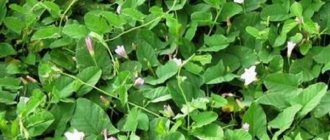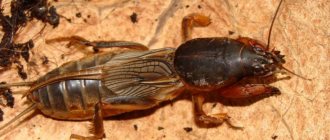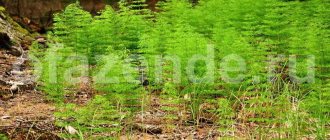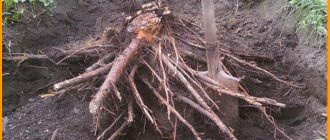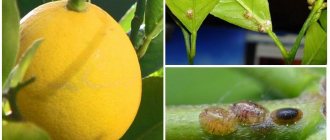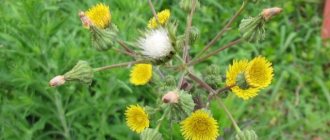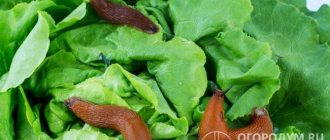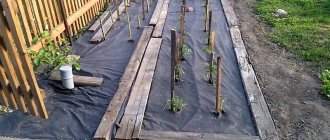Garden care
A perennial herbaceous plant called Equisetum arvense, also called the Horsetail weed or Horsetail weed, it belongs to the Equisetum family. Experts classify the genus of Horsetails as fossils with many forms, at the moment there are about 30 of them. But it is Polevoy that is so widespread in the world that it has become a real problem for gardeners and farmers. Confronting it is a labor-intensive and time-consuming process due to the characteristics and properties of the weed.
- 1 Description of the plant
- 2 Why Horsetail is a difficult to eradicate weed
- 3 How to get rid of the Horsetail weed? 3.1 Traditional methods of combating Horsetail in the garden
- 3.2 Chemicals
Description of the plant
How to get rid of horsetail in the garden is a question that worries many gardeners. It's definitely not easy. The thing is that the plant can develop on the site for a long time, spread thanks to spores, and put down powerful roots with tubers deep into the ground. Therefore, you can get rid of it by performing complex actions.
Horsetail is one of the oldest perennial plants. Its age is more than 400 million years. Grass covered part of the land even during the time of dinosaurs.
Among the characteristic features of the plant are its unusual appearance and methods of reproduction. It is noteworthy that horsetail shoots come in two varieties. The plant looks different in spring and summer. The only thing spring and summer horsetail have in common is a jointed stem consisting of nodes.
Varieties of horsetail:
- spring shoot is generative or spore-bearing. It ensures grass reproduction;
- summer shoot is vegetative or photosynthetic. Its task is to stock up on nutrients and grow a long root.
Spring shoots are also called pistils. They are eaten. They taste a little like bread. There is no chlorophyll in generative shoots. Color – gray, slightly brownish, there are shades of dirty pink.
In appearance it is a straight stem without ordinary leaves. Instead of leaves, the stem is covered with girdling teeth. The upper part of the shoot is an ovoid spike or strobile. It contains millions of spores. They are very small and weightless. The wind carries them over long distances. Some disappear because they are viable for only two days. Where they fall into favorable moist soil, new horsetail will appear.
Freshly sprouted horsetail is completely different from its older brothers. It is a green stalk 2-4 mm long. This is a gametophyte. It contains an egg and sperm. When it rains, the egg is fertilized. Afterwards, a sporophyte appears in place of the gametophyte. This is already an ordinary horsetail.
The peculiarity of the spring shoot is that it lives for about a month or a little more. Then it dries up. In summer, a vegetative shoot of horsetail appears in place of the pistils. It looks like a dwarf Christmas tree or pine tree. Stem height is from 10 to 40 centimeters. Teeth and multifaceted side shoots develop on it. The color of the plant is rich emerald.
The lower part of the shoot is represented by a long rhizome. Its length can reach more than half a meter. There are small tubers on the roots. Nutrients are formed in them. The tubers separate from the plant and develop independently. That is why the weed is very tenacious.
Another characteristic feature of the plant is that it can be found all over the world. It loves sun and moist, sandy, acidic soils. It tolerates drought or prolonged downpours without problems. He loves to settle on peat bogs. It is from these developed areas that peat soil is extracted for the garden, which is ordered by summer residents. Through the brought soil, horsetail ends up in the garden. In order to reduce this likelihood, gardeners need to carefully inspect the brought nutrient soil. The weed's long, strong, dark-colored roots are quite noticeable.
The composition of horsetail is rich. It contains fatty acids, glucose, lignin, pectin, vitamin C, and organic acids.
Medicinal properties of horsetail
On the one hand, horsetail is a malicious weed that takes nitrogen, potassium, and phosphorus from the soil and accumulates them in its nodules.
On the other hand, this is a unique medicinal plant that contains a large amount of valuable substances, as well as silicic acid, which the human body really needs. It is necessary for the construction of the skeleton, the functioning of mucous membranes, the healing of wounds and damage to the walls of blood vessels. Silicon compounds contained in horsetail prevent the formation of kidney stones. It is especially effective for diseases of the urinary tract.
Horsetail tea is recommended for use for rheumatic pain, chronic cough, diseases of the urinary tract, heart and kidneys, as well as for swelling
To prepare medicinal horsetail , 1-2 tsp. dried crushed herb is poured into 250 ml of hot water, left for 30 minutes and filtered. It is recommended to drink up to 3 cups of this drug per day.
Of course, for an ordinary summer resident, horsetail is a weed that harms plantings. Therefore, carefully check the brought soil, monitor the acidity of the soil and promptly get rid of “accidental” weeds before they have time to fill the entire area.
Why is horsetail dangerous?
This is a weed. Its danger is that, when it appears in the garden, it interferes with the full development of vegetable crops. The weed takes away moisture and nutrients that were intended for potatoes, tomatoes, cucumbers, and peppers. As a result, summer residents receive a smaller harvest than expected.
Horsetail spreads very quickly, occupying a large area in the garden. It impoverishes the land, depriving it of fertility.
The unpleasant feature of horsetail is that it is difficult to fight. In order for the weed to disappear, it is not enough to treat the area with chemicals or plow it. We need an integrated approach.
The plant, despite the fact that it clogs plantings, is often used in folk medicine. Experts advise using decoctions of green shoots with caution. They can be dangerous. They contain toxic substances that accumulate in the human body. The result is poisoning. You cannot treat with horsetail for more than two to three weeks.
Decoctions should not be drunk by pregnant women, nursing mothers, or people with low blood pressure. The plant will only bring harm to these categories. It is better to consult a therapist before self-medicating with horsetail.
Weed prevention
Horsetail will definitely appear if you do not inspect the soil brought to the garden. It is necessary to carefully inspect the soil, checking whether there are black rhizomes in it. In the new area it is worth doing deep weeding.
The weed takes root best where there is high acidity. This is why it is so important to lim the soil from time to time. Before this, you need to determine the exact level of soil acidity.
Liming is carried out using preparations containing calcium. These are chalk, ash, lime, dolomite flour. The latter is the most common and popular substance for the procedure. It not only neutralizes acidity, but also improves the properties of the earth, feeding it with magnesium. It can be used to fertilize the soil at any time, unlike lime. Every year the dose of liming substances must be reduced. In the second year it can be half as much as the first time.
Another preventative measure is to remove leaves, plant debris and weeds from the site
It is also necessary to control soil moisture. If the level is too high, this will create favorable conditions for the appearance of horsetail.
If you plant potatoes in an infected garden in the spring, the horsetail shoots will not have time to spread out to their full potential. The more shade there is from the garden crop, the worse the weed growth will be.
Horsetail does not tolerate proximity to cabbage. If you plant this garden crop in places where the weed grows, secretions from the roots will cause the horsetail to die. Radish, radish, daikon, rapeseed, and mustard have a similar repellent effect. They not only produce tasty fruits, but also drive away weeds from the garden.
Vegetation control methods
How to deal with horsetail in the garden? Firstly, it is worth understanding that this needs to be done as early as possible. The property of the plant is an annual increase in number. Secondly, the usual methods used to combat weeds are not enough. Thirdly, you can only get rid of it through comprehensive vegetation control measures. Control measures should not be one-time, but permanent. You need to do this until the area is completely free of dangerous, annoying weeds.
Among the methods of struggle are:
- Reducing soil acidity.
- Application of chemistry.
- Biological methods.
Reduced acidity
Some gardeners are not aware of the acidity of the soil they cultivate. Although this is a rather important indicator that affects productivity and the spread of weeds. Typically, high acidity of the soil occurs where it is too humid, and there is often rainy weather. Calcium is lost due to water. She washes it off.
In acidic soil, horsetail will begin to spread very quickly, taking over the area. It is this weed that will inform the owner of a field or plot about the increased acidity of the soil without any analysis.
To drive a weed out of the garden, soil deoxidation is required. In other words, you need to adjust the soil composition, making it neutral or slightly acidic. It is not difficult. However, the process is long. It can take from several months to 1-3 years.
Substances that help reduce acidity:
- Ash.
- Slaked lime.
- Plaster.
- Dolomite flour.
- Special deoxidizers.
- Chalk.
- Cement dust.
May be interesting Methods of weed control - all the pros and cons Pests of bell peppers and effective methods of controlling them Tobacco dust to protect cucumbers from most pests Before adjusting the acidity of the soil composition, the area is measured and the places that most need deacidification are determined.
Apply 0.5-0.7 kg per square meter of soil. ash. This is provided that isolation is carried out in the first year. In the second year, a smaller volume of ash can be used for the procedure. If lime is taken, then about 0.6 kg is needed. per one square meter. The owner of the site scatters it evenly on the soil. Afterwards watering is carried out. It is believed that it is best to deoxidize the soil with lime in the fall, since in summer it can damage the root systems of vegetable crops. This procedure with lime is carried out every 3 years.
Chalk, dolomite flour, and old plaster are scattered throughout the garden in a ratio of 300 grams per square meter. Deoxidizers, which can be purchased in specialized stores, are used according to the instructions.
Reducing the acidity of the soil helps fight horsetail with constant weeding and digging of the garden.
Chemicals
In addition to soil deoxidation, gardeners can use various chemicals to combat horsetail. Herbicides are effective because they remove not only the plants themselves, but also spores and root tubers.
Herbicide Prima
A chemical made from powerful components. In a short period of time it penetrates the weed and stops its growth. Death will occur within 2 weeks. The advantages of the drug are that it is not afraid of precipitation in the form of rain due to its rapid penetration into horsetail or other weeds. At the same time, the chemical quickly disintegrates in the soil and does not affect its fertility. Does not affect insects. The disadvantage is that Prima's properties are reduced during frosts.
Ground
This is a continuous action herbicide. Kills both vegetable crops and weeds. The advantage of the drug is that it effectively rids the garden of any harmful weeds, does not pollute the environment, and is safe for crops. This product has a significant advantage - it is not too expensive. The ground is applied in the spring, before planting, or after harvesting. It is sprayed over the soil. Can be applied directly to the weeds themselves. The disadvantage of Ground is that insects may suffer when using it.
Zenkor
A time-tested weed control product. Selective action herbicide. It only fights weeds. It can be used before planting and after the emergence of green shoots of agricultural crops. The drug is completely harmless to vegetables and poisonous to weeds. After the product penetrates the weed, the pest turns yellow, withers, and dies. The advantage of this drug is that it penetrates deep into the ground and has a detrimental effect on plant roots. Non-toxic for humans and insects. Among the disadvantages of Zenkor is the low effectiveness of the drug in greenhouses; in hot weather, the product can damage some hybrids.
Stomp
Selective broad-spectrum herbicide. It can be used to control a wide variety of weeds. He will not touch vegetable crops. Its disadvantages are that in hot, dry weather the product will not penetrate to the roots of the weed, but will remain on the surface of the soil.
Agrokiller
Effective against weeds and safe for other plants. Its active substance penetrates the weed, spreading along the stem, leaves, roots and destroys them. Agrokiller is sprayed onto the soil with weeds until other plants are planted. After 2 weeks, the garden can be planted. The disadvantage of the drug is that it is suitable for one-time use. Only if the product is sprayed once, it does not have a detrimental effect on vegetable crops or soil quality. In addition, the prepared solution cannot be stored. It must be used immediately for its intended purpose.
Lontrel-300
He is selective. Its advantages are that it is non-toxic, is not afraid of rain, destroys harmful plants in a short period of time, and penetrates the roots. Lontrel-300 is profitable to buy. It takes very little to cultivate a large plot of land. One liter of product is used for 3 hectares of land. The drug is often used to feed beets. To do this, it is mixed with fertilizers. The disadvantages of the drug are that it is used only once.
Roundup, according to reviews, is considered effective in combating the most annoying weeds. It should only be applied to weeds. Otherwise it will damage garden crops. The advantage of the drug is that after it you do not need to carefully dig up the soil several times. Disadvantages: long lasting effect. The weed begins to wither only after 4-5 days. The disadvantage of Roundup is that it is afraid of rain, which washes away the active substances from plants. In dry weather it is also used with caution. The procedure is best done early in the morning or in the evening.
Tornado is a continuous action herbicide, ideal for killing hard-to-eradicate weeds. Among which is horsetail. Two cultivations of the land are required. The first is carried out in the spring before vegetable crops are planted. The second is after harvesting. The advantages of the drug are that it does not accumulate in the soil and spreads throughout the entire plant – from leaves to deep roots. Disadvantages - it must be applied directly to the weeds; it will not penetrate through the ground to the roots.
Biological methods
A characteristic feature of horsetail is that it cannot grow next to some plants. For example, cabbage, mustard, radish, horseradish. Therefore, in addition to all other actions aimed at controlling the weed, these crops need to be planted on the site.
The listed methods will help gardeners master the science of how to get rid of horsetail in the garden forever. The main thing is not to give up, but to fight the weed. Then the result of the work will not be long in coming.
What to fight with
It is difficult to remove a garden weed that produces spore-bearing shoots. The earlier the fight begins, the greater the chance of saving the harvest. Horsetail feeds on nutrients from the soil, harming garden crops. It grows in all types of soil, but especially loves moist places.
The weed accumulates nitrogen, potassium, and phosphorus in its roots, stopping the development of vegetable plants. Horsetail, together with other weeds (wheatgrass and fescue), can form large thickets that will be resistant to sun, drought and excess moisture.
If you do not pay attention to the appearance of a green guest, the quantity and quality of the harvest will significantly deteriorate
The shoots and roots of the weed sometimes reach a meter in size. The plant reproduces both by spores and vegetatively - this explains its vitality. It especially loves the neighborhood of potatoes, growing on fallow lands. Even a small amount of root debris can provoke violent growth of the plant, so its removal must be taken seriously.
Biological methods of control
You can get rid of horsetail in your garden by mulching the soil with organic or inert materials. Dry grass, wood chips, tree branches, and gravel can be used as mulch. The method is to block the light and oxygen needed for horsetail growth and prevent the emergence of seedlings.
Mulching method against horsetail
Instead of mulch, you can use thick black film.
There are crops whose proximity to horsetail is detrimental. Root secretions from plants of the cruciferous family, such as:
- radish;
- rape;
- mustard;
- daikon;
- radish.
In autumn, where weeds grow, you can plant winter rye, which has the property of inhibiting the growth of other plants.
How horsetail reproduces ↑
Horsetail (common) or Pusher is a perennial, herbaceous plant, reaching a height of up to 0.5 m. It is distinguished by a highly developed root system, located quite deep (0.6-1 m). Since the reproduction of horsetail and its development is very active, it can literally fill an entire plot of land in a short time.
In the wild, it prefers rather damp places (the banks of swamps, ponds and rivers) with fertile soil. This is why horsetail grows in the garden so often; the conditions there are simply ideal for it (fertilized soil and constant watering of garden crops).
Horsetails are higher spore plants; they can reproduce by spores or vegetatively. Green spores in the shape of balls ripen in huge quantities. During the life of a plant, there is an alternating change of sexual (gametophyte) and asexual (sporophyte) generations, but asexual generations are more common and last longer.
The weed has two types of above-ground shoots:
- Spring ones are brown, chlorophyll-free (spore-bearing), erect, reaching 20 cm in height.
- Summer ones are green, segmented, branched, hollow and hard, about 60 cm high, with narrow underdeveloped leaves.
Appearance of a field weed
At the tops of spring stems, a large spikelet develops with spores that ripen in mid- to late spring and are easily carried by the wind. After which these shoots most often dry out. For the fertilization process, horsetail needs moisture on the surface; in unsuitable external conditions, more male specimens are formed.
Short spherical tubers develop on creeping rhizomes, thanks to which vegetative propagation of horsetails occurs. Thus, the field weed grows most quickly and successfully.
Therefore, the gardener more often has to deal with the manifestations of asexual reproduction of horsetail, which is a more labor-intensive process due to the great depth of its occurrence in the soil and the branching of the roots.
To prevent the harmful horsetail from reproducing sexually, it is necessary to carefully and regularly destroy spore-bearing shoots in the spring, preventing spores from developing.
Sporangia pusher
Reduced acidity
Horsetail is a plant that loves soil with high acidity. If you take this feature of the weed into account, it will be possible to eradicate it. To do this, it is necessary to reduce the acidity level. The process is quite complicated and requires a significant time investment (from six months to 2 years). You can lower the indicator by adding dolomite flour, slaked lime or ash. These remedies will give a positive result if the dosage is followed. In the first year, 2-3 kg of limestone will be required per 1 square meter of land; later this amount decreases by 6 times.
Related article:
Horsetail: photos, types, cultivation, medicinal properties and contraindications
If you combine the acidity reduction procedure with regular weeding, after a few years you will be able to completely forget about this weed.
Fact . In Japan, a plant such as horsetail is used to polish wooden products to give them an unusual shine. To do this, the stems of the plant are boiled in a special way.
Chemicals against scourge
Many summer residents are resorting to the use of herbicides when trying to get rid of green scourge. Since horsetail is not a flowering plant, but a spore plant, products such as Roundup or Tornado have a weak effect. They do not penetrate deep into the ground where the roots of the plant are located.
We also recommend:
How to get rid of purslane grass
It is best to use powerful drugs like Glyphos.
The aqueous solution has a fifth hazard class.
They have a significant disadvantage - they penetrate not only into the soil, but also into the vegetables and fruits growing on it.
The drug does not harm other beneficial insects.
Glyphos should be sprayed at night when there is no wind.
In this case, it is imperative to protect your hands with gloves and your face with a respirator. It does not harm the bees, but limits their age per day.
Only heavily grown weeds should be treated with chemicals.
If, after spraying herbicides and harvesting the crop, new plants have sprouted in the dacha, you need to weed them immediately. This way you can make it easier to care for your garden next year.
The following drugs also give good results:
- "Prima";
- "Hurricane";
- "Zenkor";
- "Agrokiller".
Their effectiveness is affected by the active vegetation of the weed. It makes no sense to introduce them during a drought - during it, the germination of plants stops and they become stressed. The best time for spraying is after rain, in the evening, when there is no wind. If rain is in the forecast, you should avoid using herbicides, as they will not have time to be absorbed into the weeds. Processing must be carried out carefully, without rushing. If at least one spore remains, the appearance of new shoots is guaranteed.

